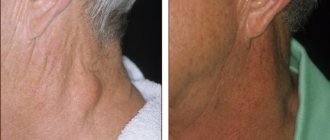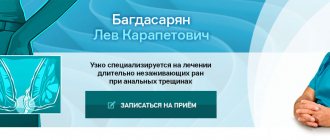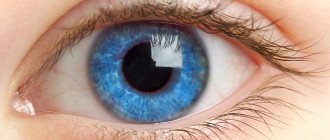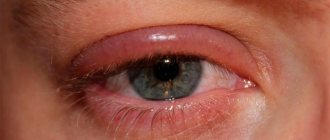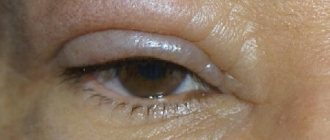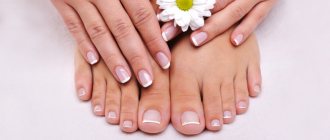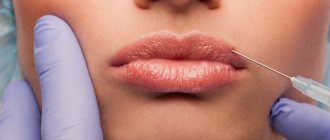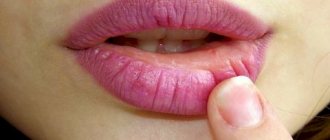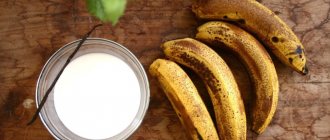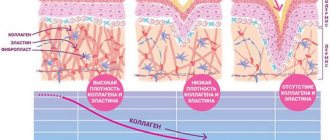Last update: 03/03/2021
Allergies on the cheeks of a child are a common phenomenon that occurs at least once in most children. Sometimes red cheeks are also called diathesis. Diathesis itself is not a disease; it is more correctly characterized as a predisposition to unusual reactions of the immune system. Below we will discuss the causes, symptoms and methods of treating cheek allergies in children.
Allergy in a child on the cheeks: causes
Allergies affecting the cheeks and face most often affect children between 3 and 6 months of age; After reaching the age of two, the disease is rare. However, in some cases, red, scaly cheeks can also be seen in older babies.
There are many reasons that can cause allergies on the cheeks of an infant and older child. These include the following:
- Features and disorders of the diet of the child and mother (with breastfeeding).
- Early or late introduction of complementary foods.
- Medicines the mother took while breastfeeding.
- The child is taking medications.
- Contact with pets.
- Hypersensitivity to plant pollen. During the flowering period of wormwood, ragweed, birch, poplar and other trees and herbs, the child may have red cheeks.
- Sensitization to dust and mold fungi.
- Response to insect bites.
- Certain foods. A food allergic reaction to a particular allergen product is very often localized on the face. Redness of the cheeks can be caused by seasonal fruits, berries and vegetables, cow's and goat's milk, seafood, chocolate, honey, chicken eggs, meat, and some types of cereals.
- Reaction to cold or heat. Redness of the cheeks during a sudden change in temperature (for example, when leaving a warm room into the cold) may be a sign of a so-called cold allergy. The same can be said about the effects of heat: the sun's rays often cause redness of the facial skin, its dryness and flaking.
- Using inappropriate hygiene products. If soap and shampoo, which contain dangerous surfactants, alcohol, artificial fragrances and preservatives, are used for bathing, hair washing and washing, the child may develop an allergy and reddened cheeks.
- Heredity. If both or one of the parents has a tendency to allergic reactions, the likelihood that the predisposition to them will be passed on to the child is quite high.
- Living in areas with unfavorable environmental conditions. It is believed that residents of large cities are more prone to allergies on the cheeks than rural residents.
In addition, cheek allergies can be caused by exposure to low-quality fabric dyes, metal objects, cosmetics or household chemicals. For example, the cause of an allergy on a child’s cheeks may be washing children’s clothes and bedding with an unsafe powder. Remember: for washing children's clothes, only eco-powders or products marked “hypoallergenic” should be used.
If your child has eczema
11.01.2022
Baby eczema looks terrible and can cause red, scaly patches to appear on your baby's sweetest face. This disease drives any mother into despair. However, you should not give in to panic ahead of schedule. It may not be eczema , but may also be a dermatological rash that goes away over time.
What does eczema look like?
Atopic dermatitis , which is what eczema , appears in 10-15% of children and manifests itself in the form of red spots that peel and are located on the cheeks or the folds of the legs and arms. A similar childhood disease is seborrheic eczema . With it, spots appear on the child’s scalp.
Ways of infection with eczema
Until this time, doctors had not precisely identified the cause of the disease, although they claim that it occurs due to a disorder of the immune system . It has been suggested that allergies to certain detergents and cosmetics may be a cause of atopic dermatitis . Heredity plays some role - if parents suffered from this disease, the probability of transmitting the disease at the gene level is 50%.
In most children with eczema , the disease goes away before the age of six or seven. Only in a few does it cross this age limit and remain for a long time. Don't forget that eczema has a period of remission.
What causes childhood eczema?
Since the cause of eczema remains unclear, the exact factors causing it are difficult to name. However, there are some conditions under which the disease is most likely to occur.
- Dry skin. It becomes sensitive, especially in winter in heated rooms.
- Irritation. All kinds of cosmetics or clothes made from rough materials cause stains on the skin.
- Stress. A child's body may respond with a rash to a stressful situation, such as vaccinations.
- Sweating . The course of the disease worsens on hot days.
- Allergy . Some pediatricians say that by eliminating milk, oranges, and peanuts from your child's menu, you can reduce the likelihood of eczema .
Treatment of eczema
Correct care of the child’s skin can contribute to the recovery and mild progression of eczema
- Moisturizing cream. After taking a bath, be sure to use a quality moisturizer. This way you will maintain the necessary level of moisture in your baby's skin.
- A warm bath will relieve the itching and calm the baby.
- Antibiotics and ultraviolet rays. In case of severe illness, it is possible to take medications after consultation with a doctor .
When a child has eczema , it is important not to let him scratch the damaged skin, as this will spread the disease to nearby healthy areas. Monitor the condition of your child’s nails and wear clothes that will hide the damaged areas from him. At the same time, it should be loose-fitting and made of soft natural fabrics. If you detect the first symptoms of the disease, consult a doctor .
Published in Dermatology Premium Clinic
Allergy on the cheeks: symptoms
Redness of the skin on the cheeks, chin and other parts of the face, the appearance of a rash, mild swelling, dry skin are the most common signs of an allergic reaction.
Among the skin manifestations, itching and flaking should also be noted - symptoms that cause a lot of trouble for the baby. From itching and burning, the child becomes restless and irritable, sleeps poorly, and may lose appetite. In addition, because of the itching, the baby will try to scratch the rash: this should not be allowed, as scratching can cause infection. Then the rashes will begin to fester and recovery will be delayed.
In some cases, allergies are accompanied by difficulty breathing, coughing, sneezing, watery eyes, photophobia, and nasal congestion.
An allergic reaction can affect the scalp: in this case, gray, yellowish or brown scales (gneiss) appear on it.
An allergic reaction can become the initial stage of inflammatory and skin diseases - eczema, dermatitis, conjunctivitis, etc.
Treatment for cheek allergies
The choice of treatment tactics depends entirely on what caused the allergic reaction. Finding and eliminating this cause should be the first step towards healing. This may require diagnostic methods such as blood tests, provocative tests, and patch tests.
Most often, if allergic reactions occur, it is recommended to switch to a hypoallergenic diet and, if possible, abandon medications; however, the decision on the amount of therapy must be made by the physician. If the child suffers from severe itching, the doctor may prescribe antihistamines and antipruritic drugs. If there are rashes or weeping erosions, the use of corticosteroid ointments and creams may be required.
Seborrheic dermatitis in children
19.07.2021
Seborrheic dermatitis is a serious pathology associated with dermatological problems. The disease is characterized by the fact that patients experience severe redness of the skin, followed by itching, flaking, the formation of hard scales, and even the discharge of pus in the affected areas of the body. The main locations of the disease are the head, ears , shoulder blades, upper chest , and the area between the nose and lips.
This disease occurs in people suffering from problems with the functioning of the sebaceous glands. Because of this, the level of subcutaneous fat, as well as its quality, changes greatly. Subsequently, the surface of the epidermis becomes vulnerable and the most favorable place for the development of fungus and other harmful organisms.
Description of seborrhea in children
This disease is a serious danger, because it can provoke the occurrence of other, more severe diseases. And at the same time, it is also very difficult to fight the disease, since often medications alone will not be enough for this, because patients will be required to strictly follow a diet and give up bad habits.
But the disease will be even more dangerous for children, since the immune system at an early age is very weak and vulnerable. Therefore, treatment will require more complex and drastic measures to prevent the occurrence of similar pathologies.
Heredity
Seborrheic dermatitis in children does not always occur due to physical infection, because this disease can also be transmitted genetically from parents. Therefore, mothers and fathers who have previously suffered from this problem should warn their child in advance and take appropriate measures.
It is quite simple to identify this disease by the characteristic scales on the child’s body, which have a rough structure and a yellow tint. And in the initial stages of the disease, small, pronounced circles with a black tint form on the body at the epicenter of the source of infection.
Dermatitis also be identified by the presence of dandruff on the baby’s head, but unlike the standard problem, the epidermal flakes will be much larger and more voluminous.
Causes of seborrheic dermatitis in children
According to statistics, more than 50% of babies suffer from this disease in the first months of life. This is due to disruptions in the hormonal system, which negatively affect the functioning of the immune system and protection from external threats. Seborrheic dermatitis in an infant can be provoked during the period of intrauterine development if the mother has hormonal problems at all stages of pregnancy .
Disruption of the system also occurs in children during puberty, since due to major changes in the body, the immune system and its protective functions are greatly weakened. Therefore, teenagers are very vulnerable at this time.
Other reasons for the development of the disease should be highlighted, such as:
- genetic predisposition;
- vulnerability to allergic reactions ;
- disturbance of intestinal ;
- the presence of chronic or infectious pathologies;
- a long course of taking medications that can greatly weaken immunity ;
- problems with the stomach and digestive system;
- poor child care, violation of hygiene rules;
- pregnancy complications ;
- improper feeding;
- prolonged stay in environmentally polluted places.
Symptoms of seborrheic dermatitis in children
Severe redness on the scalp, on the shoulder blades, face and even in the groin. This symptom can be identified by a characteristic shade of grayish color, with black dots in the center of the source of infection. The following symptoms may also be present:
- severe itching;
- the formation of yellow scales in places where the disease is localized;
- presence of large dandruff on the head;
- oily hair color;
- discharge of pus in damaged areas;
- fragility and hair loss.
Seborrheic dermatitis on the head of a child is classified into several categories, according to the severity of the disease:
- dry - occurs when the efficiency of the sebaceous glands decreases, due to which the surface of the epidermis dries and forms rough scales that easily peel off;
- greasy - occurs when the secretion of organic secretions is too active and is characterized by giving the skin and hair an oily tint and structure. In later and more severe stages, ulcers or acne ;
- mixed - the most complex type of disease, which can simultaneously combine the symptoms of oily and dry seborrhea ;
Treatment of seborrheic dermatitis in children
Self-treatment of the disease is not recommended, as this may lead to the risk of complications. Initially, you should consult a dermatologist who can perform an ultrasound and find the main cause of the disease.
As for treatment, it mainly focuses on normalizing the functioning of the sebaceous glands, since in most cases they contribute to the formation of the disease. If seborrhea on the head in children, treatment occurs not only with the help of medications, but also with the use of a special shampoo, which will help prevent the spread of the fungus and will help restore damaged skin.
If the child is already a teenager, then you should additionally build a diet in such a way that the diet does not contain fatty foods, fast food, and instant food. Adding spices, salt and hot sauces negatively affects the treatment processes.
Prevention of seborrheic dermatitis
If the disease has been successfully defeated, then it is too early to relax, because to further protect the baby, a set of preventive measures should be carried out. These include:
- mobile and active lifestyle;
- compliance with personal hygiene rules;
- maintaining optimal temperature conditions in the house;
- removing things from the room that can cause allergic reactions ;
- proper and regular feeding;
- strengthening the immune system through good sleep and walks in the fresh air;
- use of medicated shampoos and soaps.
Published in Dermatology Premium Clinic
Allergy on the cheeks of a child: how to treat it, besides traditional medicine?
Treating cheek allergies in a one-year-old child using traditional recipes is a risky idea. During this period, you can use only external remedies - lotions, compresses and baths with the addition of decoctions of string, violet, and oak bark.
In any case, before starting to use traditional medicine recipes, do not forget to consult a pediatrician or allergist.
“La-Cri” products and their help in the treatment of allergies on the cheeks of a child
Upon completion of the main stage of therapy, you should focus on eliminating the most unpleasant external symptoms. La-Cri cosmetics can help you with this:
- La-Cri cream relieves itching and redness, soothes irritation;
- Emulsion "La-Cri" moisturizes and nourishes dry skin, reduces sensitivity;
- Cleansing gel "La-Cri" gently cleanses the skin and helps reduce the degree of negative environmental impact.
These products contain plant extracts, safe oils, panthenol, bisabolol and other useful components. At the same time, La-Cri creams, gel and emulsion do not contain parabens, fragrances or hormones, so they can be used even for the smallest children with sensitive skin.
Clinical researches
Conducted clinical studies prove the high efficiency, safety and tolerability of products for daily skin care of children with mild and moderate forms of atopic dermatitis and during remission, accompanied by a decrease in the quality of life of patients. As a result of therapy, a decrease in the activity of the inflammatory process, a decrease in dryness, itching and flaking was noted.
La-Cri cosmetics are recommended by the St. Petersburg branch of the Union of Pediatricians of Russia.
Sources:
- Yukhtina N.V., Modern ideas about atopic dermatitis in children
- Kamasheva G.R., Khakimova R.F. Valiullina S.A., Methods for assessing the severity of atopic dermatitis in young children, Dermatology journal, 2010
- G.V. Molokova, E.V. Bukina, Diaper dermatitis in children with sensitive skin, Journal of Dermatology and Allergology, 2019
- N.L. Rybkina, Modern approaches to newborn skin care: pediatrician tactics, journal Bulletin of Modern Clinical Medicine, 2014
Photos of allergies in children
Photo album on the diseaseRough skin in a child: on the legs and arms. Why and what to do?
A child differs from adults in having healthy skin, since his body is not yet poisoned by toxins. But as soon as a parent begins to care for it incorrectly, irritation, redness and dryness may occur. And they mostly affect the limbs.
- Causes of rough skin in children
- Diseases
- Allergy
- What to do for rough skin
- How to properly moisturize rough skin on your hands and feet
In order not to get confused in such a situation, I suggest reading today’s article here on the website o-kozhe.ru, which will tell you why rough skin appears on a child’s legs and arms, and what to do about it.
A child differs from adults in having healthy skin, since his body is not yet poisoned by toxins.
Non-drug treatment
First of all, you need to adjust and normalize the baby’s nutrition. It is understood that it is necessary to exclude the food allergen; if the child is breastfed, then the mother should analyze her own menu and exclude from it foods that could theoretically trigger an allergy outbreak.
It is imperative to pay attention to the mother’s intestinal function. If she constantly suffers from constipation, then toxins resulting from stool retention are absorbed into the blood and passed on to the baby through the woman's milk. To combat constipation, the mother can use lactulose, suppositories with glycerin and increase the consumption of fermented milk products.
If the child is bottle-fed, you should seek help from a doctor - you may need to change the previously selected formula for feeding.
If dry and rough skin appears after introducing complementary foods, parents should stop giving the baby a new product and feed only familiar foods for two weeks. Parents must remember: each new product is introduced as complementary food separately, addiction should last at least 3 weeks, which will allow the true irritant to be identified with great accuracy.
If the child is over one year of age, then you need to keep a diary of observations of the body’s reaction to different foods. It is imperative to exclude fish, eggs, citrus fruits, cheeses and strawberries from your diet - foods that most likely cause allergies. Subsequently, they can be administered, but in minimal quantities.
In addition, you should remember the following recommendations from doctors:
- Sweets are strictly contraindicated for children with rough and dry skin (atopic dermatitis), as they increase fermentation in the intestines and improve the absorption of allergens. Consumption of honey, sweet drinks and jelly leads to deterioration of health.
- Preservatives, stabilizers, emulsifiers and flavor enhancers, and exotic fruits are prohibited for children with this phenomenon.
- The child needs to be provided with a full volume of fluids, since a lack of fluid in the body leads to constipation.
- It is important not to overfeed your baby. For example, when artificial feeding, a small hole is made in the nipple so that the baby eats his portion of the mixture in 15 minutes - this way he will receive pleasure and a feeling of satiety.
- The first complementary food is vegetable puree. And the most hypoallergenic foods are cauliflower and zucchini.
- The air in the children's room should always be fresh, slightly cool and sufficiently humidified. Only in this case will it be possible to prevent sweating and dry skin.
- Children's clothes should be washed with hypoallergenic phosphate-free powder and rinsed at least 3 times in clean water. If dryness and roughness of the skin is in a progressive stage, complicated by a bacterial infection, then rinsing the laundry will need to be done in boiled water.
- Your child's dishes and toys should be washed regularly with hot water. This must be done without the use of chemical detergents/cleaners.
- The child should walk in the fresh air every day, for at least 3 hours and in any weather. If you have to go for a walk on frosty days, then the baby’s face must be lubricated with rich baby cream.
Atopic dermatitis occurs in waves - periods of exacerbation are followed by periods of remission. But even during periods of “calm”, parents must follow certain rules:
- When bathing a child, do not use a washcloth;
- shampoo and baby soap for bathing can be used no more than once a week;
- After bathing and drying, the skin should be moisturized with baby cream, milk or a special moisturizing lotion;
- You need to lubricate your child’s skin not only in areas of flaking and dryness, but throughout the entire body;
- You need to wash your child’s face and perineal area as often as possible, and you can use wet hypoallergenic wipes for this.
The use of sorbents Smecta, Enterosgel, Sorbogel, which help remove toxic substances from the body.
